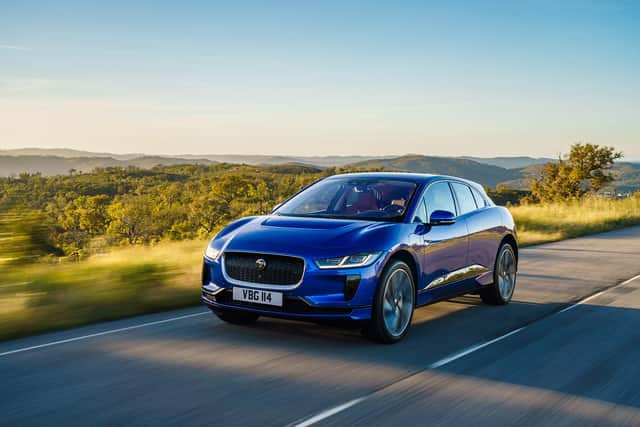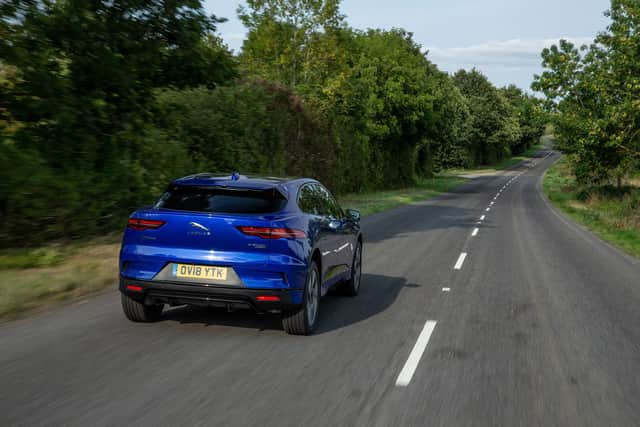MOTORS REVIEW: Jaguar I-Pace


Its distinctive styling separates it from anything else in the Jaguar Land Rover stable in impressive style and the massive 22-inch alloy wheels of my test car only accentuated its futuristic look.
A hushed whirr is the only thing that accompanies a seatback squishing 4.8 second acceleration to 62mph which rarely fails to surprise in a car that, to all intents and purposes, possesses the dimensions of a modern mid-sized SUV.
Advertisement
Hide AdAdvertisement
Hide AdBut for all the fanfare and fashionable premium polish of the I-Pace, its success could be determined by just what the current generation of electric vehicle (EV) customers deem to be the currency of such a vehicle.
I say this because, during my week with JLR’s debut pure EV, it never looked like getting within 100 miles of the 292-mile maximum range claimed under the new, more accurate WLTP test regime.
Coming just a few weeks after a somewhat understated £32,995 (after the £3,500 government grant) breathed new confidence into EV driving with an ability to easily approach 300-miles on a charge, that looks like a huge blow for a vehicle that looks to compensate with a bit of show.
In the case of my I-Pace test car a bit of show had been transformed into quite a lot, though, after JLR went to town on the options list.
Advertisement
Hide AdAdvertisement
Hide AdA basic list price of £60,995 (again after the £3,500 government grant) rose to a whopping £80,980 with: £1,650 Matrix LED Headlights; an eye-watering £2,900 for those big alloys (replacing 18-inch alloys); £3,940 for some very cool-looking 14-way heated and cooled Performance seats and £1,350 for a “Drive Pack” including Blind Spot Assist, Adaptive Cruise Control with Stop & Go and High-Speed Emergency Braking.
In my eyes this kind of options list tomfoolery elevates the I-Pace from breakthrough EV to luxury car exotic and, while the car looked and felt great, removed the accessibility that can really benefit the wider adoption of alternative fuel vehicles (AFVs) right now.
That said, it did look fantastic and attracted more admiring glances and questions than any other EV I’ve run to date… so perhaps this is that way to get at least part of the message out there.
The Sienna Tan leather contrasted the exterior’s Caesium Blue metallic paint (£700) and light flooded in through a full-length panoramic roof (£960).
Advertisement
Hide AdAdvertisement
Hide AdJLR’s two-tiered centre console sees an upper screen control the sat nav and entertainment functions as the lower hi-res display gives access to the climate control, heated seat and steering wheel functions.
It’s a system that looks and functions very well but isn’t as intuitive as the Volkswagen Group or BMW alternatives and the graphics of the maps lacks the sharp Google Maps-generated images of the former.
A head-up display (£900) delivers speed, sat-nav and traffic sign information into the driver’s eyeline, meanwhile.
Driving the I-Pace really is a hoot.


My reservations about range might have been tee’d up by a 210-mile claim on the instrument binnacle upon completion of a full charge, but there were no similar shortcomings when it came to performance.
Advertisement
Hide AdAdvertisement
Hide AdWith my efforts to extract maximum range out of the way, a blast in the I-Pace revealed that it not only delivers family lugging capability, but sports car humbling acceleration.
All those batteries mean that this is a pretty heavy car — tipping the scales at around 2.1 tonnes — but while that can manifest itself in a little lean into corners, the twin electric motors’ (one front, one rear) ability to shift power between individual wheels to aid the car’s traction and trajectory mean that it tracks a chosen line gamely.
Four-wheel drive traction and power and torque of 400PS and 696Nm from zero revs means that it feels far faster than its claims.
While it’s not on the same level as the quickest Teslas, overtaking and accelerating is an eyewidening joy for anyone who is unused to anything this side of a genuine supercar.
Advertisement
Hide AdAdvertisement
Hide AdOne area where it can’t compete with the Tesla is in terms of charging.
Where investment in a Tesla buys you access to the excellent Supercharger fast-charge network, IPace owners will have to rely on a home charger or the mixed-bag of public charge points.
Jaguar claims that recharging the batteries to 80 per cent capacity from flat via a 7kW wall box takes 10 hours, while 50kW public chargers reduce that time to 85 minutes, but the last 20 per cent seemed a little slow to take during my test.
I was genuinely impressed by the I-Pace. Its styling, both inside and out, its pace and the attention it attracted were all notable while its premium build quality was way beyond that of a Tesla.
Advertisement
Hide AdAdvertisement
Hide AdHowever, in practical terms the things that transformed my experience of driving an EV the most over the past 12 months have been the convenient and speedy charging served up by the Californian disruptor brand and the excellent real world range and greater affordability of the Kia e-Niro.
Like I said, the choice comes down to where you place the most value or — indeed — whether value is a concern at all…